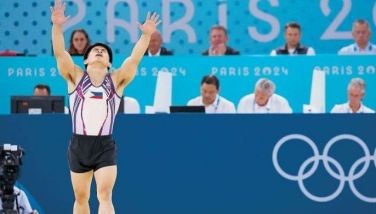‘Choir of the World’
December 10, 2003 | 12:00am
In last Sunday’s pre-Yuletide concert at the F. Santiago Hall, the UST Singers under Fidel Cala-lang, Jr. presented a program that ranged from the classics, to the international, to Broadway and West End musical hit tunes, to Filipino songs and finally, to Christmas carols, including our own in Pilipino.
Winner of the "Choir of the World" grand prize in Wales in 1995, the UST Singers, consisting of students and alumni, proved at the concert why they garnered such a title. To begin with, Prof. Calalang as pianist, choral conductor, composer, singer and choral arranger, might be described as a "compleat" conductor, having trained in many musical disciplines that have enlarged his perspective and tightened his grasp of choral singing. In fact, Prof. Calalang received the "Best Conductor" prize at the 2nd Tonen 2002 International Choral Competition in Monster, Netherlands.
By the same token, his arrangements maximized the aural appeal of the songs, each of which the singers had committed to memory, thus enabling them to give full attention to articulation, expression, volume, cadence, rhythm, etc. while deriving their cue from the conductor.
Under Prof. Calalang’s vigorous, intelligent and acutely sensitive direction, the choir delighted, surprised, amazed or awed whether singing a cappella or occasionally, to piano accompaniment provided by the conductor himself in songs widely diverse in style, mood, spirit and substance.
The choir elicited reverential awe in Q. Magnum Mysterium by Morten Lauridsen, its ebbing pianissimos ending in hardly audible sounds, its electrifying fortissimos nearly shaking the rafters. John Rutter’s The Saints Go Marchin’, for its part, drew the most rousing enthusiasm as rendered by 18 male singers in thunderously powerful resonances.
The mixed choir evinced comfortable familiarity with the text – whether classic or contemporary – rich tonal colors, blending of textures in linear lines or polyphony, and incredible extremes of vocal range. The interpretations, even of the classics, were fresh and innovative.
Two selections, in particular, demanded virtuosity and considerable resiliency: 1) Cloudburst by Eric Whitacre sung with the enrichment of brass percussion and finger-snapping which seemed to signify raindrops falling at intervals after a brief, frightening thunderstorm, and 2) Ruben Federizon’s new familiar Gabaq-an, with ethnic instruments accompanying strange yet never discordant voices in varying ranges and intensities, and staccato bursts of sound.
Winner of the "Choir of the World" grand prize in Wales in 1995, the UST Singers, consisting of students and alumni, proved at the concert why they garnered such a title. To begin with, Prof. Calalang as pianist, choral conductor, composer, singer and choral arranger, might be described as a "compleat" conductor, having trained in many musical disciplines that have enlarged his perspective and tightened his grasp of choral singing. In fact, Prof. Calalang received the "Best Conductor" prize at the 2nd Tonen 2002 International Choral Competition in Monster, Netherlands.
By the same token, his arrangements maximized the aural appeal of the songs, each of which the singers had committed to memory, thus enabling them to give full attention to articulation, expression, volume, cadence, rhythm, etc. while deriving their cue from the conductor.
Under Prof. Calalang’s vigorous, intelligent and acutely sensitive direction, the choir delighted, surprised, amazed or awed whether singing a cappella or occasionally, to piano accompaniment provided by the conductor himself in songs widely diverse in style, mood, spirit and substance.
The choir elicited reverential awe in Q. Magnum Mysterium by Morten Lauridsen, its ebbing pianissimos ending in hardly audible sounds, its electrifying fortissimos nearly shaking the rafters. John Rutter’s The Saints Go Marchin’, for its part, drew the most rousing enthusiasm as rendered by 18 male singers in thunderously powerful resonances.
The mixed choir evinced comfortable familiarity with the text – whether classic or contemporary – rich tonal colors, blending of textures in linear lines or polyphony, and incredible extremes of vocal range. The interpretations, even of the classics, were fresh and innovative.
Two selections, in particular, demanded virtuosity and considerable resiliency: 1) Cloudburst by Eric Whitacre sung with the enrichment of brass percussion and finger-snapping which seemed to signify raindrops falling at intervals after a brief, frightening thunderstorm, and 2) Ruben Federizon’s new familiar Gabaq-an, with ethnic instruments accompanying strange yet never discordant voices in varying ranges and intensities, and staccato bursts of sound.
BrandSpace Articles
<
>
- Latest
- Trending
Trending
Latest
Trending
Latest
Recommended


























